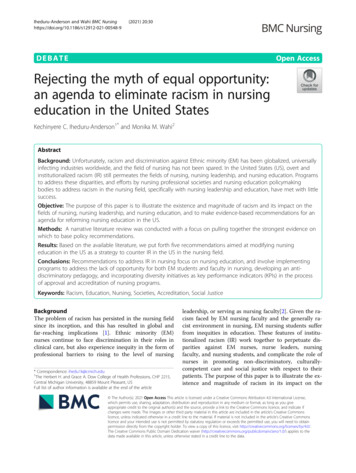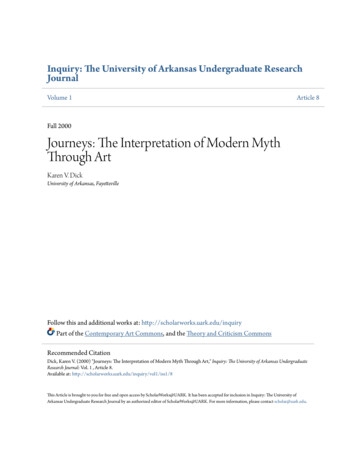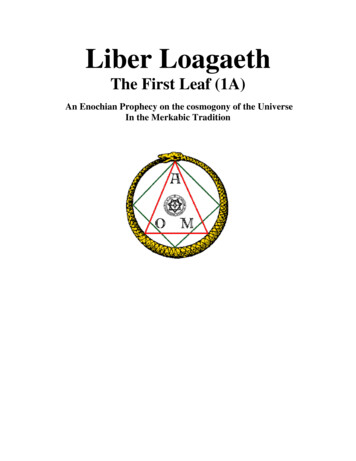
Transcription
Iheduru-Anderson and Wahi BMC 2021) 20:30DEBATEOpen AccessRejecting the myth of equal opportunity:an agenda to eliminate racism in nursingeducation in the United StatesKechinyere C. Iheduru-Anderson1* and Monika M. Wahi2AbstractBackground: Unfortunately, racism and discrimination against Ethnic minority (EM) has been globalized, universallyinfecting industries worldwide, and the field of nursing has not been spared. In the United States (US), overt andinstitutionalized racism (IR) still permeates the fields of nursing, nursing leadership, and nursing education. Programsto address these disparities, and efforts by nursing professional societies and nursing education policymakingbodies to address racism in the nursing field, specifically with nursing leadership and education, have met with littlesuccess.Objective: The purpose of this paper is to illustrate the existence and magnitude of racism and its impact on thefields of nursing, nursing leadership, and nursing education, and to make evidence-based recommendations for anagenda for reforming nursing education in the US.Methods: A narrative literature review was conducted with a focus on pulling together the strongest evidence onwhich to base policy recommendations.Results: Based on the available literature, we put forth five recommendations aimed at modifying nursingeducation in the US as a strategy to counter IR in the US in the nursing field.Conclusions: Recommendations to address IR in nursing focus on nursing education, and involve implementingprograms to address the lack of opportunity for both EM students and faculty in nursing, developing an antidiscriminatory pedagogy, and incorporating diversity initiatives as key performance indicators (KPIs) in the processof approval and accreditation of nursing programs.Keywords: Racism, Education, Nursing, Societies, Accreditation, Social JusticeBackgroundThe problem of racism has persisted in the nursing fieldsince its inception, and this has resulted in global andfar-reaching implications [1]. Ethnic minority (EM)nurses continue to face discrimination in their roles inclinical care, but also experience inequity in the form ofprofessional barriers to rising to the level of nursing* Correspondence: ihedu1k@cmich.edu1The Herbert H. and Grace A. Dow College of Health Professions, CHP 2215,Central Michigan University, 48859 Mount Pleasant, USFull list of author information is available at the end of the articleleadership, or serving as nursing faculty[2]. Given the racism faced by EM nursing faculty and the generally racist environment in nursing, EM nursing students sufferfrom inequities in education. These features of institutionalized racism (IR) work together to perpetuate disparities against EM nurses, nurse leaders, nursingfaculty, and nursing students, and complicate the role ofnurses in promoting non-discriminatory, culturallycompetent care and social justice with respect to theirpatients. The purpose of this paper is to illustrate the existence and magnitude of racism in its impact on the The Author(s). 2021 Open Access This article is licensed under a Creative Commons Attribution 4.0 International License,which permits use, sharing, adaptation, distribution and reproduction in any medium or format, as long as you giveappropriate credit to the original author(s) and the source, provide a link to the Creative Commons licence, and indicate ifchanges were made. The images or other third party material in this article are included in the article's Creative Commonslicence, unless indicated otherwise in a credit line to the material. If material is not included in the article's Creative Commonslicence and your intended use is not permitted by statutory regulation or exceeds the permitted use, you will need to obtainpermission directly from the copyright holder. To view a copy of this licence, visit http://creativecommons.org/licenses/by/4.0/.The Creative Commons Public Domain Dedication waiver ) applies to thedata made available in this article, unless otherwise stated in a credit line to the data.
Iheduru-Anderson and Wahi BMC Nursing(2021) 20:30fields of nursing, nursing leadership, and nursing education, and to make evidence-based recommendations foran agenda for reforming nursing education in the UnitedStates (US).MethodsA narrative review was conducted, as it is appropriate tosummarize the findings from a collection of studies thathave used diverse methodologies and theoretical conceptualizations [3]. Articles included in this review were selected on the basis of the quality and utility of theevidence they provide [3].DefinitionsRacism has been defined as, “A phenomena (sic) that results in avoidable and unfair inequalities in power, resources, and opportunities across racial or ethnicgroups” [4]. Racism can be expressed in different ways,including, “Through beliefs (e.g., negative and inaccuratestereotypes), emotions (e.g., fear/hatred), or behaviors/practices (e.g., unfair treatment), ranging from openthreats and insults (including physical violence) to phenomena deeply embedded in social systems andstructures” [4]. Racism has also been described asinstitutional or individual practices that create a systemby which racial or ethnic groups are continuallyoppressed [5].Race and ethnicity, therefore, refer to sociallyconstructed (rather than biologically-constructed)groups who often share the same cultural heritage andancestry [5]. These systems of socially-constructed raceand ethnicity groups are actually forged by oppressivesystems created by majority groups using ideology inwhich the story explains why the majority group shouldbenefit from dominating over the other groups, andshould continue to define itself as well as the othergroups through this domination relationship [5]. Further,these systems continue to define these oppressed racialand ethnic groups by way of possession of selective andarbitrary physical characteristics (most notably skincolor) [5]. It follows, then, that discrimination againstEM refers to the process by which members of thesedefined, oppressed racial and ethnic groups are treateddifferently (usually unfairly) simply due to their believedmembership in the group [5].Although a decline has been observed in overt racistattitudes in contemporary society due to social unacceptability, it is unclear to what extent actual individuals still believe in racial stereotypes or ideologies [6].Because of this, a discussion of IR cannot be completewithout a discussion of white privilege [7, 8]. Accordingto DiAngelo [7], it is normal for common discourse toinclude racially-coded language, such as “urban,” “innercity,” and “disadvantaged” when talking about blackPage 2 of 10people, but not using the terms “white”, “overadvantaged” or “privileged” when talking about white people(p. 55). She asserts that this coded language reproducesracist images and perceptions while it simultaneouslyperpetuates the comfortable illusion that race, and problems associated with race, are the fault of EM [7].Liu [9] discussed the formation of privileged identities,using the following definition of privilege: “a multiidentity act that is facilitated and supported by institutions and organizations” (p. 349). These institutions actas “power-governors” that function to support an ideology of white supremacy (p. 349), and this way, actorswithin the system function to perpetuate and legitimizethis inequity so that it is maintained as the status quo[9]. IR is related to the concept of implicit bias, which isa belief that is triggered unconsciously that holds that aparticular group is inferior, or otherwise sees a particulargroup with a negative attitude [6].Results & discussionBoth overt racism and IR have impacted the field ofnursing in many different ways. The impact of racism innursing extends to nursing leadership and nursing education, and ultimately results in negative consequencesfor patients who deserve culturally-competent and nondiscriminatory care. This section will explain how thiscomplex system of both overt racism and IR has workedto integrate racism into the very foundations of nursing,nursing leadership, and nursing education.Racism in NursingRegrettably, racial discrimination against EM happens inall countries, universally impacting all sectors, withoutsparing the field of nursing [1, 10]. As an illustration ofthis, although as of July 1, 2017, EM made up over 38 %of the United States (US) population [11], findings fromthe 2017 National Council of State Boards of Nursing(NCSBN) Workforce Survey, which includes US nurses,showed that only 19.3 % of registered nurses (RN) identified as EM [12].This phenomenon is not only present in the US. Inthe United Kingdom (UK), The Royal College of Nursing (RCN) acknowledged that IR is a problem in UKnursing [13]. Studies in both the US and the UK haverevealed pay disparities, in that the average hourly wagefor black RNs is lower when compared to white RNs[14–17]. The Journal of Nursing Management (JNM)conducted a survey in 2010, and included samples ofnurses from the US, Saudi Arabia, Canada, China, andNew Zealand [18]. They found that among nurses whoreported making over 120,000 annually, over 90 %were Caucasian [18]. By contrast, this highest incomestratum only included 4 % of black nurses, and 2 % ofHispanic or Asian nurses [18].
Iheduru-Anderson and Wahi BMC Nursing(2021) 20:30An interview study was conducted in the UK amongnursing managers who were asked about their experiences with black African nurses [19]. On one hand, themanagers described how they observed these nurses being treated in racist ways by both patients and colleagues[19]. But the managers also reported that these nursessuffered from racism that was coming from the job itself,such as not being provided equal opportunities for andexperiencing discrimination from colleagues and managers [19].The issue of racism directed at EM nurses from manydifferent sources is particularly apparent when considering internationally-educated nurses (IEN), or nurses whooriginate in non-Western countries and transition toWestern workplaces, such as those in the UK, US,Canada or Australia [20, 21]. One interview study ofChinese IENs transitioning to the US found several mainthemes, including “injustice and discrimination” comingfrom many different sources, including patients, colleagues, managers, and employers [22]. A study from theUK also described this phenomenon of injustice and discrimination directed at EM nurses from multiplesources, and called it “racist bullying” [23]. A differentstudy examining barriers and facilitators for EINs successfully transitioning to a Western work setting foundthat a common barrier was racism, and a common facilitator was developing skills to counter racism [24].Braithwaite has described how IR has been institutionalized in the nursing field as part of an extension of colonialism [25]. The 1960s was a period of migration,where EM female nurses moved to the UK and formerUK colonies in search of work [25]. Over time, the overtracism these women initially experienced decreased, butthis colonialism was still embedded in the foundation,and this colonialism continues to present itself in theform of disparities in how white and EM nurses aretreated in the UK [25]. In this way, Braithwaite arguesthat modern day UK nursing remains colonized, and EMnurses are modern day victims as they struggle againstracial stereotypes and institutions that continue to robthem of power [25]. Although the history of colonizationin the US is different, the US has a similar problem asthe UK, where African slavery and other historicalevents have embedded racism into the foundations ofthe healthcare system, thus continuing historical racismand health inequities with respect to EM nurses and patients [26].Barbee wrote a landmark paper in 1993 that focusesspecifically on why racism has been perpetrated in USnursing [27]. She highlights four attributes of nursingthat inadvertently create weaknesses in the field, makingit susceptible to be co-opted with racist ideas [27]. First,nursing emphasizes empathy, and this leads to the corollary that all patients should be treated equally withoutPage 3 of 10consideration of race [27]. This attribute creates the unintended barrier of nurses being uncomfortable to admitracism is in the field, because that suggests the operational practice of empathy in nursing may need reform.Second, nursing emphasizes an individual orientation,which encourages taking focus off of structures in society that might be a source of influence, such as socialnorms and political climate [27]. This same principlethat encourages nurses to treat the poor and the richequally also has the unintended effect of leading nursesto turn a blind eye to a patient’s socioeconomic status.This tendency distracts nurses away from perceiving theintersection between race and socioeconomic status, andfrom seeing the connection between racism and povertyin their patients [27].Third, in order to develop efficient protocols for delivering nursing services and education, the nursing fieldprefers homogeneity with respect to both patients andstudents [27]. Favoring homogenous patient and nursepools as part of structuring and delivering nursing services and education runs counter to the real level of diversity with respect to the wide variation among actualpatients and nurses [27]. Hence, this preference operationally is translated into resistance to accommodatingthis real diversity in both patient and nurse populations[27]. Finally, the nursing field emphasizes a desire tomaintain a peaceful climate in the workplace by avoidingconflict [27]. While this seems reasonable, it inadvertently presents resistance to other nursing functions, suchas identifying and addressing safety problems, or otherissues that might cause workplace conflict as anoutcome of legitimate business processes [27]. The consequence of the principle of emphasizing conflict avoidance essentially provides cover to those in the nursingfield, especially leaders, who want to avoid openly addressing the scourge of racism in the workplace underthe guise of maintaining a peaceful climate [27].Racism in Nursing LeadershipRacism in the nursing field has impacted the demographics of nursing leadership over time. The Institutefor Diversity in Health Management (IDHM), which isan affiliate of the American Hospital Association (AHA),conducted a national survey in 2015 of over 6,000 chiefexecutive officers (CEOs) of hospitals in the US [28].The survey found that only 14 % of hospital boards werecomprised of EM, only 11 % of hospital executive leaderswere EM, and among first and midlevel managers, only19 % were EM [28]. This lack of EM at leadership levelsprompted the US National Academy of Medicine(NAM), formerly called the Institute of Medicine (IOM),to make a call for efforts to increase EM representationin nursing leadership in their 2010 report [29]. The results of NCSBN Workforce Survey in 2015 that was
Iheduru-Anderson and Wahi BMC Nursing(2021) 20:30mentioned earlier revealed that 14.6 % of black or African American nurses in the US have nursing-associatedmasters or doctoral degrees compared to 13.4 % of whitenurses, so there exists a qualified pool of potential EMleadership candidates [30].The UK also struggles with this problem. As reportedin the Health Service Journal in 2016, a panel discussionwas held to discuss the problem of lack of EM amongthe ranks of nursing leadership in the UK [31]. Thepanel concluded that the National Health Service (NHS)trust boards failed with respect to their duty to promoteEM representation in nursing leadership [31]. As evidence, they cited a decrease in black people appointed toNHS trust boards from a high of 9.6 % in 2006 to a decrease to 8 % in 2014 [31]. EM staff in the NHS havebeen found to have fewer opportunities for developmentand career progression, so a range of initiatives and interventions were deployed by the NHS to address this[13, 32]. Yet, as shown by the results of the discussionpanel, these initiatives, which were implemented duringa stretch of time that included the period between 2006and 2014, did not increase EM participation in nursingleadership. In fact, over this period of time, EM participation actually decreased.Ironically, in the study mentioned earlier about the observations of nursing managers in the UK of racism directed at black African nurses, the managers themselvesat times expressed racist views [19]. Specifically, themanagers reported that they perceived that black Africannurses lacked motivation to pursue promotions or professional development [19]. This situation presents aunique challenge for efforts aimed at addressing racismin nursing leadership. Since EM RNs report barriers topromotional and development opportunities morefrequently than their white counterparts, thischaracterization of the issue as “lack of motivation”when the real issue is “lack of opportunity” illustrates apotentially vicious cycle [2, 20, 33].The lack of EM represented among nursing leadershiphas several implications. First, it is challenging to conceive of being able to provide “culturally competent”care within a framework of a field where underlying issues of racism and discrimination have not yet been adequately examined and confronted [34]. Althoughcultural competence in nursing is admittedly ill-defined,it roughly translates to the idea of being openminded toethnic and cultural diversity among patients, and working to accommodate these differences when deliveringnursing care [35, 36]. Nurses are ostensibly expected todeliver so-called culturally competent care, but this verymandate is problematic when called for within a fieldwhere racism is pervasive and relatively unchecked [17].Lack of culturally competent care has been identified asone of the causes leading to health disparities in patients,Page 4 of 10so this inattention to structural racism in the nursingfield results in barriers to its ability to confront the negative impact of racism on patient health [17]. Second, thesituation where nurse leaders believe that EM nurseslack motivation for career development, when in realitythey are being actively blocked from advancement,represents a toxic barrier to addressing IR in nursing[37–39]. Third, the barriers to EM leadership in nursing result in a lack of EM role models in advancedpositions in nursing [40]. As mentoring and rolemodeling are critical to the transfer of knowledge innursing, lack of EM role models in nursing compromises the opportunity for professional developmentamong EM nurses in clinical care and nursing leadership as well as academia [40].Racism in Nursing EducationIR causes challenges for EM in all areas of academia,not only nursing. One study showed the rate of EMfaculty in general is often disproportionately low, andthat once EM faculty are hired, they are typically subjected to both subtle and overt racism, are the subjects of stereotypes and racist assumptions, and aremarginalized [41]. Further, EM faculty often find theirresearch discredited, especially if it is on a topic ofspecific relevance to EM populations, and are treatedwith tokenism [41]. In a grounded theory study conducted by Hassouneh and colleagues, it was foundthat non-EM faculty employed strategies of exclusionand control aimed at preventing EM faculty fromhaving equal access to workplace opportunities [37].Another study of African American nursing facultyfound similar themes, including lack of clarity in jobexpectations, lack of job security, lack of diversity inthe workplace, and an experience of racism [38].Another issue in nursing and nursing education is thatthe educational content itself has problems with racism.Studies of education in medical professionals have foundthat learning experiences tend to be rife with racial bias[42, 43]. Although race is a social construct, it is oftentaught in health professions as a biologic feature, andthis misunderstanding promotes biased thinking amongclinicians [42]. Teaching about racism in nursing is another challenge, as one study of white nursing facultyfound that their whiteness obscured their understandingof race, and therefore, they were not well-prepared toteach about race and racism [44]. A different study ofUK nurse lecturers found that these educators were unconfident about their own abilities to teach about culture and racism, and address those topics in theircurricula [45]. On the other hand, research shows thatappropriating EM faculty to teach about racial conceptsis not a viable solution, because they risk being tokenized [37, 41].
Iheduru-Anderson and Wahi BMC Nursing(2021) 20:30Another reflection of racism in nursing education isseen in the lack of faculty diversity. In the 2013 NCSBNworkforce survey, it was found that EM nurses were underrepresented in nursing education at the faculty andadministrative levels [46]. According to estimates by theAmerican Association of Colleges of Nursing (AACN),the percentage of nursing faculty that were EM in theUS overall was 16 % in 2016, and specifically for full professors, it was only 10 % [47]. The National League forNursing’s (NLN’s) 2017 Faculty Census Survey foundthat over 80.9 % of nursing faculty were white, and African Americans only made up 8.8 % of full-time nursingeducators [48]. Because there are so few EM among theranks of the nursing faculty, these EM tend to have experiences as a “token” or a “lone ranger”, and not treatedwith equal status [49]. Hassouneh explains how theseare manifestations of unconscious racist bias that serveas a barrier to developing a diverse nursing faculty, andprovides examples that include inadequate career developing pipelines; disproportionately rare opportunitieswith respect to appointment, promotion, and tenure;and an unwelcoming academic environment overall [50].Racism also taints the delivery of nursing education. Afocus group study by Tilki and colleagues aimed tounderstand the experiences of racism in nursing education by students and lecturers [51]. Although overt racism was not routinely apparent, there was clearevidence of IR through Eurocentric values embedded inorganizational culture and practices [51]. As an example,despite the fact that ethnically diverse students wereprevalent in the educational setting, they were still considered the “other” [51]. A different study focusing onAfrican American nursing students reported that mostparticipants stated they faced racial discrimination ineducation [14]. These repeated reports of nursing students experiencing racism in their educational settingsexemplifies the weak institutional commitments madeby nursing colleges to students, and especially EM students [14].This weak institutional commitment is also evident instudies that show that EM students face barriers in nursing learning environments [52]. These barriers could beseen as falling in two categories: those directly related tothe student’s personal circumstances, and those relatingdirectly to the nursing faculty and nursing educationlearning environment [52]. The lack of institutional support of EM students in nursing schools has a profoundimpact on these students. In 2016, the NLN published areport titled “Achieving Diversity and Meaningful Inclusion in Nursing Education,” where the authors emphasized that nursing pipeline programs are the key toimproving representation of EM students in health professions [53]. This is relatively aspirational in the currentenvironment, where one study found that only 20 % ofPage 5 of 10nursing schools had a structured diversity pipeline program [54].Racism impacts nursing education at all levels, andthis has two particularly important implications. First,because nursing students are acquiring their skills in thesetting of a racist educational environment, they will notbelieve to develop aptitude in delivering culturallycompetent care [34]. Second, as the US healthcare system is rife with well-documented racial health disparities, ironically, nursing has been promoted as theprofessional field tasked with addressing this [55]. Giventhe racism inherent in the nursing field at all levels including education, it is difficult to imagine US nursingadequately addressing the pervasive problem of racialhealth disparities in the US healthcare system.Programs to increase diversity in Nursing EducationPrograms exist to increase EM diversity in nursing education that are aimed at students as well as faculty [56].It is possible to measure the climate of IR and how welcoming the workplace environment is to EM at both thestudent and faculty level [57]. One set of authors recommend teaching nursing students a “code of conduct” thatcould lead to inclusion and diversity in their patients;this could be adopted as a code of conduct to apply toentire nursing programs, including all the professionalsand students in the program [58].In terms of students, because EM students may havefeatures that make them require extra support, interventions aimed at empowering or otherwise intervening onethnic minority nursing students have been proposed[59]. These programs may be aimed at recruitment, retention, or both [60, 61]. However, these programs oftenhave so many barriers to participation that EM nursingstudents cannot benefit from them. One example in theRobert Wood Johnson Foundation (RWJF) Future ofNursing Scholarship Program [62]. The program provides scholarships, mentoring, leadership developmentopportunities, and when applicable, post-doctoral research support to EM nurses for the purposes of building leadership capacity [62]. The program providesmonetary support for EM nurses seeking doctoral education as well as one-year of competitive post-doctoralsupport [62]. However, there is a lot of effort involved inapplying for this program and participating in it, andmany EM nurses do not have the resources or ability toparticipate in such an intensive program. Further, it islimited to nursing doctoral students.For faculty, programs can include leadership and mentoring programs. For example, the University of Tennessee Health Science Center (UTHSC) College of Nursingdeveloped a Minority Faculty Fellowship Program aimedat developing and promoting Hispanic faculty, thusaddressing the pipeline problem [63]. Again, these
Iheduru-Anderson and Wahi BMC Nursing(2021) 20:30programs face the problem that EM nurses, nursingleaders, and nursing faculty are already suffering fromracism in terms of less advancement, lower pay, and lackof opportunity. One example program is from the Minority Nurse Leadership Institute (MNLI) at RutgersUniversity, which offers a 10-month mentored leadership development curriculum [64]. Participants activelyparticipate in ten Saturday seminars over the schoolyear, meet monthly with a leadership mentor, andcomplete a team project designed to improve evidencebased nursing practice [64]. While this program seemslaudable, there are often barriers to participation at thislevel for EM nurses, who already face lower pay at theirjobs and may not have extra time to participate. Further,participation in programs such as these often needs tobe approved or otherwise supported by the EM nurse’sadvisor or supervisor at work, and that can pose an opportunity for control strategies to be used to prevent theEM nurse from participating [37].Response from professional societiesProfessional nursing organizations have attempted to address the problem of racism in nursing in different ways.The American Nurses Association (ANA) published aposition statement in 2018 about the nurse’s role in addressing discrimination, but it was very general and didnot make any recommendations for dealing with theroot causes of racism in nursing [65]. The InternationalCouncil of Nurses (ICN) also does not address the issuedirection. The closest position statement the ICN has tothe topic of eliminating racism in nursing is the one addressing cultural and linguistic competence, which againdoes not examine how to deal with the root causes of racism in nursing [66].While EM professional nursing organizations like National Black Nurses Association (NBNA) play an important role in the elevation of EM nurses to leadership, theycannot be tasked with eliminating racism in nursing[67]. As was shown by the research presented earlier,many non-EM nursing educators do not feel prepared toteach cultural and race issues in nursing, yet, nursingeducation still holds the goal of teaching “cultural competence” [34].Governance of Nursing Education in the United StatesIn the US, in order to obtain a nursing license to practice, one must pass the National Council LicensureExamination-Registered Nurse Examination (NCLEX),but in order to qualify to sit for the NCLEX, the individual must graduate from a nursing program approved bythe state-level board of nursing (BON) of the state inwhich the nursing program resides [68]. For this reason,BONs must stay synchronized with respect to educational standards such that across the US, approvedPage 6 of 10nursing programs perform at least minimally to thepoint that an acceptable proportion of their students areable to pass the NCLEX [68]. This synchronization is facilitated by the participation of the BON in the NCSBN[68]. Currently, there are no NCSBN requirements aboutEM nursing students or faculty that are part of criteriafor approval of a nursing program [68].Approved nursing programs in the US may choose toseek accreditation, which is a non-governmental, voluntary, self-regulatory and peer-review process by which torecognize educational nursing programs that meet orexceed standards and criteria set to ensure higheducational quality [69]. The three nursing program accreditation bodies in the US are the Accreditation Commission for Education in Nursing (ACEN) [69], theAme
nursing in many different ways. The impact of racism in nursing extends to nursing leadership and nursing edu-cation, and ultimately results in negative consequences for patients who deserve culturally-competent and non-discriminatory care. This section will explain how this complex system of both overt racism and IR has worked










